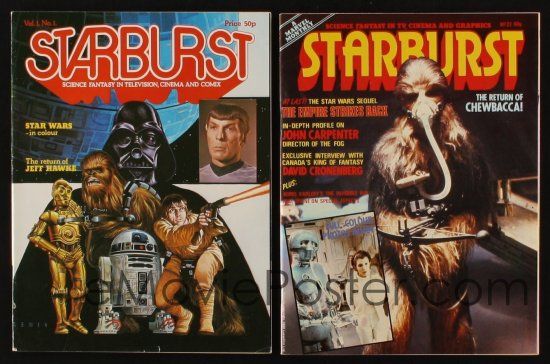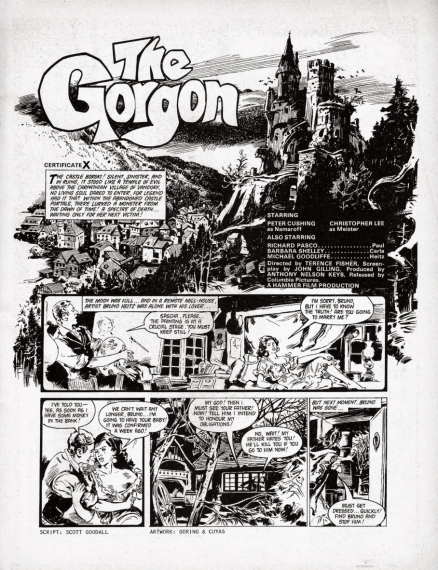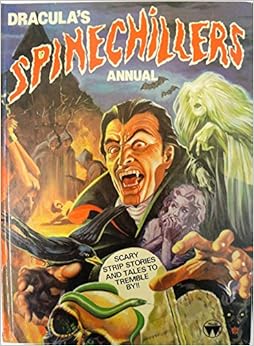Famous Monsters of Filmland was an American
genre-specific
film magazine, started in 1958 by publisher
James Warren and editor
Forrest J Ackerman.
1958–1983
Famous Monsters of Filmland was originally conceived as a one-shot publication by Warren and Ackerman, published in the wake of the widespread success of the package of old horror movies syndicated to American television in 1957. But the first issue, published in February 1958, was so successful that it required a second
printing to fulfill public demand.
Its future as part of American culture was immediately obvious to both men.
FM offered brief articles, well-illustrated with publicity stills and graphic artwork, on horror movies from the silent era to the current date of publication, their stars and filmmakers. Warren and Ackerman decided to aim the text at late pre-adolescents and young teenagers.
In the pages of
FM, Forrest J Ackerman promoted the memory of
Lon Chaney, Sr., whose silent works were mostly beyond the accessibility of fans for most of the magazine's life, but were a great influence on his own childhood. He also introduced film fans to
science fiction fandom through direct references, first-person experiences, and adoption of fandom terms and customs.
The magazine regularly published photos from
King Kong (1933), including one from the film's infamous "spider pit sequence", featured in Issue #108 (1974) which, until Ackerman discovered a photo of a spider in the cavern setting, had never been proven definitively to have actually been filmed.
FM's peak years were from its first issues through the late 1960s, when the disappearance of the older films from television and the decline of talent in the imaginative film industry left it with a dearth of subject matter acceptable to both editor and fan.
During the 1970s, the magazine came to rely heavily on reprints of articles from the 1960s.
In the early 1980s, the magazine folded after Warren became ill and unable to carry on as publisher, and Ackerman resigned as editor in the face of the increasing disorganization within the captainless Warren Publishing Company. The magazine stopped publication in 1983 after a run of 191 issues.
Revival (1993–2008)
Famous Monsters of Filmland was resurrected in 1993 by New Jersey portrait photographer and monster movie fan Ray Ferry. After finding that the
Famous Monsters of Filmland title had not been "maintained" under law, Ferry filed for "intent to use" for the magazine's trademark, unbeknownst to Ackerman or the trademark's owner and creator, Jim Warren.[
citation needed] Ferry, poised to restart publication of
FM on a quarterly basis, offered Ackerman the position of editor-in-chief for a fee of $2,500 per issue, which he accepted. Starting at issue #200, the new
Famous Monsters acquired subscribers and over-the-counter buyers who believed they would be reunited with Ackerman in print. While Ferry tried to maintain Ackerman's style in his own writings, he heavily edited and rejected contributions from the man himself.
In an effort to help Ferry finance his full-time efforts on behalf of
FM, Ackerman agreed to a reduced editor's fee of $1,500 per issue. With four consecutive unpaid issues and a continued rejection of his work, Ackerman resigned from his position. Aside from removing Ackerman's name from the masthead, Ferry did not inform
FM readers that they were no longer reading material by, or authorized by, Ackerman.[
citation needed] Instead, Ferry infused his writing with Ackerman's trademark puns, and mimicked his writing style, which led to legal action brought forth by Ackerman.
Libel lawsuit
In 1997, Ackerman filed a civil lawsuit against Ferry for
libel,
breach of contract, and misrepresentation; Ferry had publicly claimed that Ackerman’s only connection with the new
FM was as a hired hand and that Ferry “had to let Forry go” because he was no longer writing or editing for the magazine. Ferry also claimed rights to pen names and other personal properties of Ackerman. On May 11, 2000, the Los Angeles Superior Court jury decided in Ackerman's favor and awarded him $382,500 in compensatory damages and $342,000 in punitive damages.
[8][9] This verdict was appealed by Ferry, but the verdict was upheld by the
Appellate Court of California, on November 12, 2002.
[10] With judgments in Ackerman's favor, Ferry filed for bankruptcy. This is detailed in
Jason V Brock's definitive documentary on
Forrest J Ackerman,
The AckerMonster Chronicles!.
As of mid-2007, Ferry had been allowed to continue to publish issues of
FM due to lack of efforts on the part of bankruptcy trustees and Ackerman's lawyers to force the sale of the trademark or personal assets attached to his income. Ferry had also failed to pay any of the $720,000-plus cash judgment against him.
2008 to present
In late 2007, Philip Kim, an entrepreneur and a private equity investor, purchased the rights to the logo and title, entering into an agreement with Ackerman to use his trademarks to retain the magazine’s original look and feel. The new Famous Monsters of Filmland website was launched in May 2008 and on December 7, 2009, Kim announced the magazine's return to print.
Ackerman died just before midnight on Thursday, December 4, 2008.
The revival of the classic horror magazine came in July 2010, with the publication of
Famous Monsters of Filmland #251 at the Famous Monster Convention in Indianapolis, Indiana. The success of the print magazine at the Famous Monster Convention and Comic-Con International in San Diego yielded the announcement of the magazine's expansion in distribution and circulation into major bookstore chains and independent retailers throughout North America and select markets in the US, Canada, and UK. Publisher Movieland Classics, LLC announced concurrently that the magazine would be entering into a bi-monthly publication schedule to meet the significant increase in requests from captivated readers beginning with Issue #253. As executive editor of the magazine, Ed Blair steered FM starting with Issue #256 in 2011 through issue #282 in 2015, which saw the transition of editorial leadership go to current executive editor David Weiner, a 13-year veteran of the syndicated television program Entertainment Tonight.












